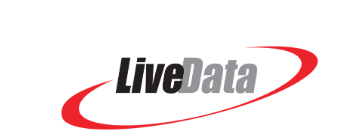Executive Summary on LiveData:
- Optimizing the hospital operating room is top of mind for every hospital leader across the nation.
- LiveData is a smart OR partner that helps maximize surgical capacity and efficiency. Their team holds decades of hospital workflow expertise.
- LiveData’s suite of specialized OR-specific solutions makes scheduling easier, streamlines OR workflows, and provides end-to-end wraparound services for procedure service lines and the perioperative suite.
- Their solution results in real financial impact – an average 34% increase in block utilization, 54% decrease in cancellations, and 5% case volume increase.
- Book a demo with them today to learn more about the offering!
The Hospital OR Throughput Problem
The operating room (OR) and perioperative suite is the lifeblood of a health system’s operation. This space is where major surgeries happen and make or break a hospital’s financial performance. We all saw what happened to hospital and health system performance when elective surgeries and utilization collapsed during the pandemic. These surgeries are the revenue driver for a hospital, generating up to 70% of a hospital’s topline, and the main source of contribution margin. But having imprecise scheduling or no insight into where your operational bottlenecks or unused OR time lie creates throughput challenges that directly affect both patient outcomes and experience as well as eventual financial performance.
Service line directors, clinical leaders, and hospital execs hear constantly about the day-to-day challenges of operating an OR efficiently:
- How can I maximize surgical time and capacity?
- I know how much time my physician says she needs for surgery – but is that actually the right amount of time to block?
- Where are my bottlenecks? Is it environmental services? Scheduling friction between physicians? How can I reduce administrative frustration for my nurses during long days of complex surgeries?
- How can I track,record and leverage real-time data to make informed decisions on how to improve?
- Dr. Flaky cancelled – he’s actually on vacation today. Can we get someone else booked today so that revenue isn’t lost?
An empty OR is a problem. Every minute of vacancy presents material opportunity cost and lost revenue. Each empty but open operating room can cost up to $1,000 per hour. And depending on the facilities and/or subspecialist procedures, even a single minute of OR downtime can present an opportunity cost of up to $100.
Here’s where the tricky nuances lie, as the details always matter in healthcare. If you’re a surgery scheduler that couldn’t see block time open up on a given day, it’s a missed surgery for a patient who could have recovered faster. And it’s a missed revenue opportunity for your hospital. If you’re a coordinator that worked miracles around an overbooked morning only to learn too late that the afternoon had cleared, it’s a daily headache. And if you’re an executive trying to improve overall throughput and push that down to your service lines, solving for optimizing OR utilization and revenue, it’s the big ticket issue you’re trying to solve… fast.
Stated simply, managing OR scheduling, planning, analytics, and growth is a complex endeavor. So with the OR throughput problem in mind, I’d like to introduce Hospitalogists to a company that has been helping hospitals and health systems solve for OR bottlenecks, efficiency issues, scheduling headaches, and better real-time analytics. That company is LiveData – your smart OR partner.
Here’s how they do it.
How LiveData Solves for Common Operational Headaches with its Smart Perioperative Platform
Many hospitals understandably ask, “Don’t our EHRs already handle this?” In a word, “No”. EHRs like MEDITECH and Cerner weren’t designed with surgical workflows in mind and therefore aren’t specialized for the perioperative suite. EHRs vary in capability, but because they try to do something for everybody, in every care situation, they miss the nuances that would materially help individuals in the operating room.
This is where LiveData’s tools plug in. LiveData PeriOp Manager, LiveData’s surgical workflow optimization software, has been quietly powering hospitals since it took a leading role in an Operating Room of the Future project at Massachusetts General Hospital in 2001 funded by a grant from the US Army. It integrates with existing EHRs, acting as a system of engagement to provide surgical-specific coordination and real-time analytics. PeriOp Manager’s full suite of products includes capabilities across everything an OR team would want and need to drive better surgical outcomes. LiveData’s suite is clean, efficient, simple, and gets the job done well.
LiveData also goes beyond the OR, extending its OR functionality to procedure service lines (e.g., gastroenterology, cardiology, pulmonology, and radiology rooms). It unites surgical, interventional, and anesthesia coordination all on one platform.
With its comprehensive offerings augmenting the OR and procedure rooms, what began for LiveData and their team as a solution primarily focused on improving patient safety and case growth has evolved into a centralized, real-time platform with features for high-visibility scheduling, data analysis, improved communication, error reduction, and more.

While some tools only offer block optimization and analytics, PeriOp Manager includes more in a feature-rich, cost-effective surgical workflow solution. The platform streamlines the surgical journey from end-to-end, benefiting everything from surgical consultation and block and schedule optimization, to day-of patient flow and awareness, OR safety, and retrospective analytics.
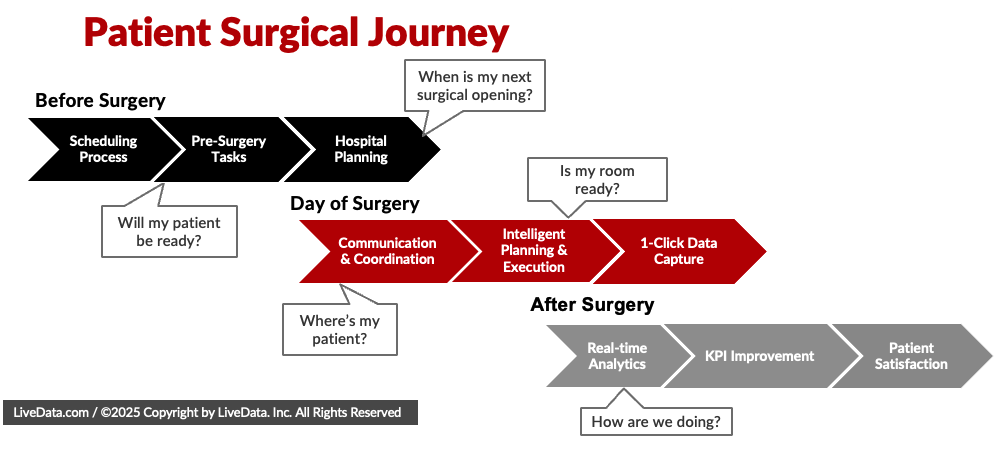
In 2025, there’s a distinct movement away from point solutions into platforms.
A comprehensive perioperative solution needs to have complex functionality during a day of surgeries bringing together multiple parties. Coordination and collaborative teamwork in the OR is paramount, and LiveData simplifies the complex interactions within teams – whether nurses, surgeons, anesthesiologists, sterilization, environmental, or recovery – reducing friction and increasing safe hand-offs, leading to more efficiency.
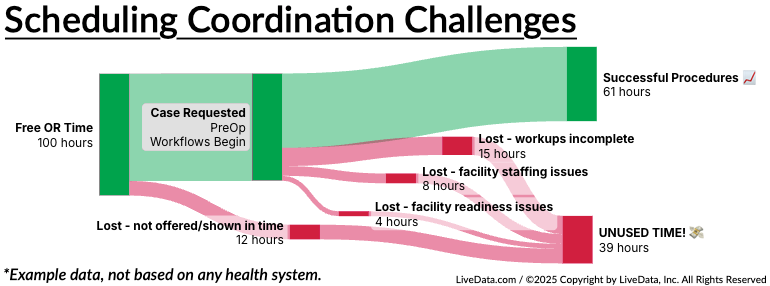
So let’s dive into LiveData’s platform itself with an overview of their features.
An Overview of PeriOp Manager’s Offerings
As a reminder, PeriOp Manager is the complete package of all of LiveData’s offerings. It’s purpose-built to integrate seamlessly into the EHR with the exact functionality needed to address OR and procedure suite workflows.
Join the thousands of healthcare professionals who read Hospitalogy
Subscribe to get expert analysis on healthcare M&A, strategy, finance, and markets.
No spam. Unsubscribe any time.
Here’s a quick one-liner on each of the modules within PeriOp Manager:
- PeriOp Planner: Supercharged scheduling tool which allows digital, phone tag-free cross-coordination between surgical offices and hospitals. Curated views of hospital blocks, built-in preop workup uploads, automatic reminders to surgeons around their first case of the day, and proactive scheduling capabilities, all eliminating scheduling friction.
- OR-Dashboard with Active Time Out: Customizable briefings and debriefings. Integrates multiple layers of patient information (EHR, anesthesia, monitoring devices) on the OR screen to provide a real-time view of the surgical case.
- OR-Schedule Board: Provides a real-time, dynamic view of all the day’s procedures – including any up-to-the-minute changes or updates – showing surgeons and clinicians exactly what’s going on (e.g. incision, room turnover) and where they’re needed.
- Family Waiting Board: Families can keep track of the surgery of their loved ones in HIPAA-compliant fashion. Texts family members about their loved one’s progress.
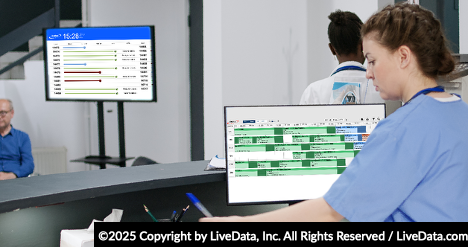
- PREFcards: Visually clear surgical preference cards associated with each case and surgeon. Can be edited in bulk, so that updating a brand of gloves doesn’t require 2,000 separate updates your team can’t get around to.
- Patient Flow: Real-time integration of patient pre-op status into perioperative workflows. Automation of check-in and check-out display once the patient arrives.
- PreOp Board: Instead of a magnet or whiteboard system, PeriOp Planner is electronic and app-based, meaning everyone involved with every facet of the surgery pre and post-op workflow knows the status of surgeries.
- PeriOp Manager Analytics: Hand in hand – literally – with the Clicker (we’ll get to that!), the analytics suite takes data from day-to-day surgeries and translates that information into actionable insights to improve upon quality, compliance, and surgical throughput. You can see the information-dense analytics dashboard below:
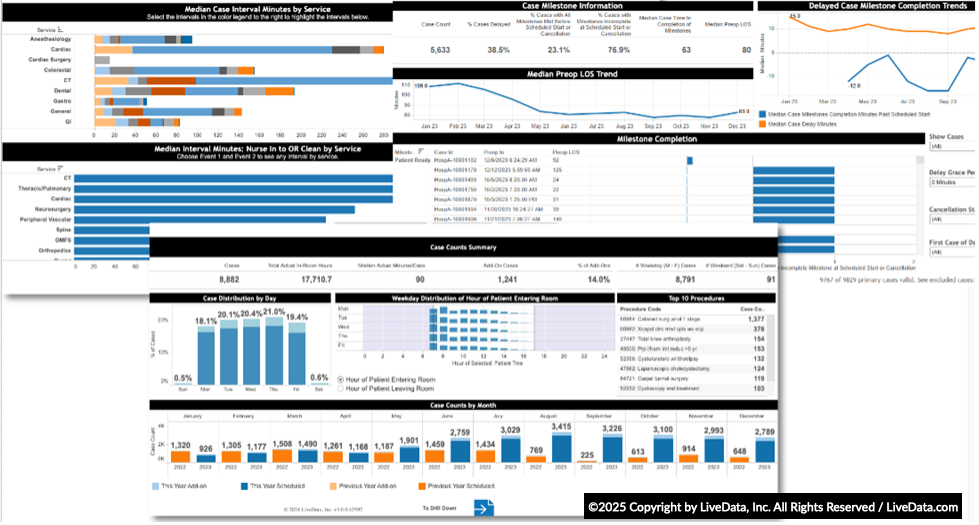
Diving Deeper: PeriOp Planner, Day-Of-Surgery Displays, Analytics and “The Clicker”
LiveData PeriOp Manager is supported by a number of inventive real-time modules. I’ll cover the central parts of the platform in more detail.
LiveData’s PeriOp Planner – Surgical Scheduling How it SHOULD Be
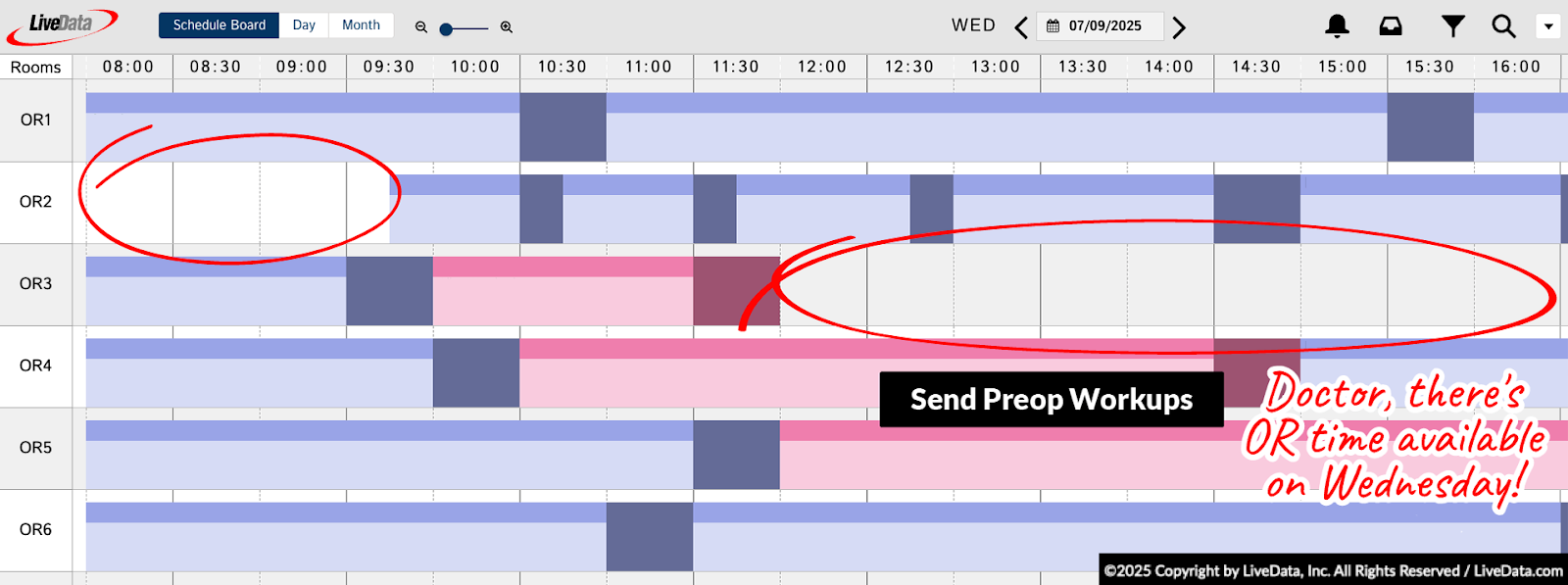
PeriOp Planner is LiveData’s bread and butter. It offers an advanced surgical scheduling calendar, and it provides a curated view of a hospital’s block schedule for ALL relevant parties to take the guesswork out of surgical scheduling.
As most of us know, scheduling in healthcare is a huge challenge with a ton of moving parts. PeriOp Planner gives hospitals a web interface to share their OR block schedule with independent clinics. Those physicians at clinics can see open timeslots they can request in real-time instead of attempting back and forth phone calls. Because surgeons and their schedulers can find open blocks easily AND cross-coordinate complicated preop workups with the same speed, implementing LiveData drastically reduces friction with multi-physician surgical booking and increases satisfaction among physicians – they appreciate a digital front door as much as patients do. PeriOp Planner can also be used to optimize schedules day-of, and quickly switch up cases as needed.
Without this level of visibility into a facility’s OR schedule, physicians may find it a hassle to book with that particular hospital and therefore will opt for other facilities offering cleaner scheduling capabilities (like LiveData’s!). In 2025, scheduling tools like these are increasingly table-stakes as we move toward digital, user-friendly OR administration. If the scheduling component is solved and the process is easy, the OR is filled and surgeons keep coming back.
Simply put, PeriOp Planner makes the hospital easier to do business with, bringing more cases to facilities. When one suburban acute care facility with 10 operating rooms and 3 procedure rooms was having an issue with their bookings, they worked with LiveData to integrate PeriOp Planner with the hospital’s EHR. They then began a 1-month pilot with a few surgical practices in the area. Before the pilot could even be completed, a majority of eligible practices were asking to join. Following a wider rollout, 24 of 35 surgical practices scheduling cases at the hospital elected to do so using PeriOp Planner.
On a commercial level, the amount of friction an advanced scheduling tool reduces is felt across surgical practices and hospitals. There’s value added by speeding up case bookings, but also in attracting new providers and cases thanks to intuitive, high-visibility scheduling tools.
Planner’s functionality also includes the ability to add work-ups as case scheduling progresses. If a patient needs cardiac clearance, Planner users can confirm online when and where it has been completed. Not only do hospital schedulers find the workflows easier, but so do the surgical office practices. Reducing friction on both sides leads to better surgical relationships and also…increased compensation and productivity for the surgical subspecialists on that side as well.
OR-Dashboard and Introducing…THE CLICKER
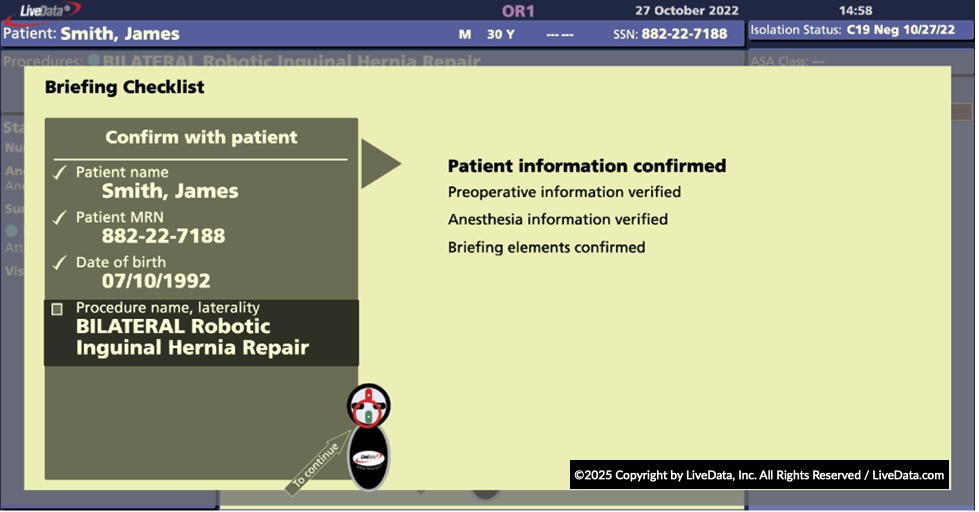
OR-Dashboard is placed inside the operating room, providing maximum visibility to the entire OR staff and making briefings, systems integration, and documentation much simpler.
With Active Time Out, OR-Dashboard also promotes safe surgery checklist compliance, which is essential to prevent “never events” like wrong site surgery. LiveData’s solution digitizes the pre-surgery checklist, providing an easy and interactive way to complete checklists, record accurate timestamps (e.g. surgery start), and integrate information from OR instrumentation on one screen (supporting situational awareness).
Without such a solution, you run the risk of incomplete checklists prior to start and inefficient recording of information during surgery. Nurses may be left to run back and forth to the documentation station, or scribble down notes that they’ll enter into the EHR later, which impacts accuracy, patient flow, data completeness, and safety.
Clients have praised OR-Dashboard for its ease of use, impact on clinical staff satisfaction and patient safety, and the fact that it can be customized to a facility’s needs.
A noted cancer center of excellence added OR-Dashboard to each of 21 OR rooms in their new facility to promote safety. Based on their success with OR-Dashboard, they expanded it to endoscopy and interventional radiology rooms.
Another hospital asked for extensive debriefing customization, including adding a “specimen screen.” It’s not uncommon to mislabel or miss samples of specimens during a procedure. On the specimen screen, surgeons can now confirm that the number of samples are correct and logged consistently in the EHR, instead of finding out the next day. This had a huge impact, as it helped to smooth critical pathology workflows.
THE CLICKER

Here’s a fun innovation the LiveData team told me was a game-changer for nurses and reducing screentime (sorry, couldn’t help myself with the meme). A standout feature among clinical staff is a simple but powerful device called the Clicker, a handheld clicker used to capture critical timing events.
With device in hand, a simple click of the appropriate button (there are only 4!), and an easy toggle feature to record any specifics, the circulating nurse can move the team through the time out checklist, visible on the monitor for everyone in the OR.
Checklist items such as introductions made, orally confirmed procedure information, or safety precautions reviewed are acknowledged by the team in real-time. When the checklist is complete, the view transitions to showing all pertinent patient data, such as heart rate and temperature. Everyone can see this data throughout the surgery, which reduces surgical interruptions like having to ask how the patient is doing or what their heart rate is.
Ultimately, the Clicker provides an easy way to document time out, following a situationally aware methodology, without leaving the patient, without leaving the team, and without having to go to a computer to document.
Here’s what’s fascinating about the Clicker though – it captures discrete data/timing events in real time and feeds that information directly into the Analytics side of the platform, creating significant synergies. From there, over time, Clicker data turns into extremely powerful and accurate datapoints for leaders to drive optimization throughout the OR.
For instance, it’s much easier to drill down into pre-op and post-op inefficiencies. Maybe housekeeping is taking too long to turn over a room and it’s an indication more environmental services staff are needed. Or perhaps post-op is taking too long and adjustments need to be made to future schedules. Finally, actual surgical time estimates for specific procedures grow much more accurate over time when using the Clicker, an objective source of truth versus the timing estimates given by a physician.
A Communication Gamechanger: Day-of Schedule Boards
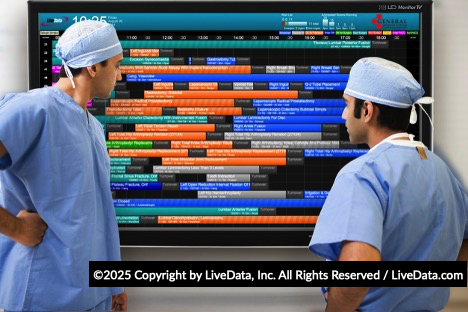
Strategically placed throughout the perioperative suite, OR-Schedule Board provides real-time visibility, at a glance, into where clinical staff is needed. Everyone throughout the OR knows when the patient is ready for the next step, maintaining the intended pace of the OR.
These boards can also be placed in administrators’ offices for monitoring surgical schedule progress. The CEO of one client added an OR-Schedule Board display in their office so that they could see surgeries and procedures in real time, knowing these were critical drivers of income. This enabled them to work more closely with their CNO.
A lot of ORs use a magnet and whiteboard system for coordinating surgeries. The process is straightforward enough, but there are several drawbacks to using this approach instead of an automated, electronic scheduling system.
For one, manual scheduling and data entry is prone to human error like double booking and forgetting to note important details. It also requires interaction at the whiteboard itself, which means disrupting your workflow to visit it or risking delays in information sharing because you can’t see it. And precious intelligence about your day-to-day operations is LOST every time the board is erased! This data is gold to mine!
At best, this necessitates staff running from room to room to keep others updated. At worst, the schedule gets behind, mistakes are made and frustrations mount.
With whiteboards, it’s also difficult to track changes or feel confident you’re looking at the most up-to-date information. They can get cluttered and difficult to read. And whiteboard use doesn’t scale easily.
OR-Schedule Board solves these issues. When an update is made, everyone can see it live. Additionally, Planner’s automated scheduling systems send reminders and alerts to surgeons, reducing no-shows and ensuring everyone is informed. EHRs and whiteboards aren’t built with the functionality to provide real-time updates at a glance.
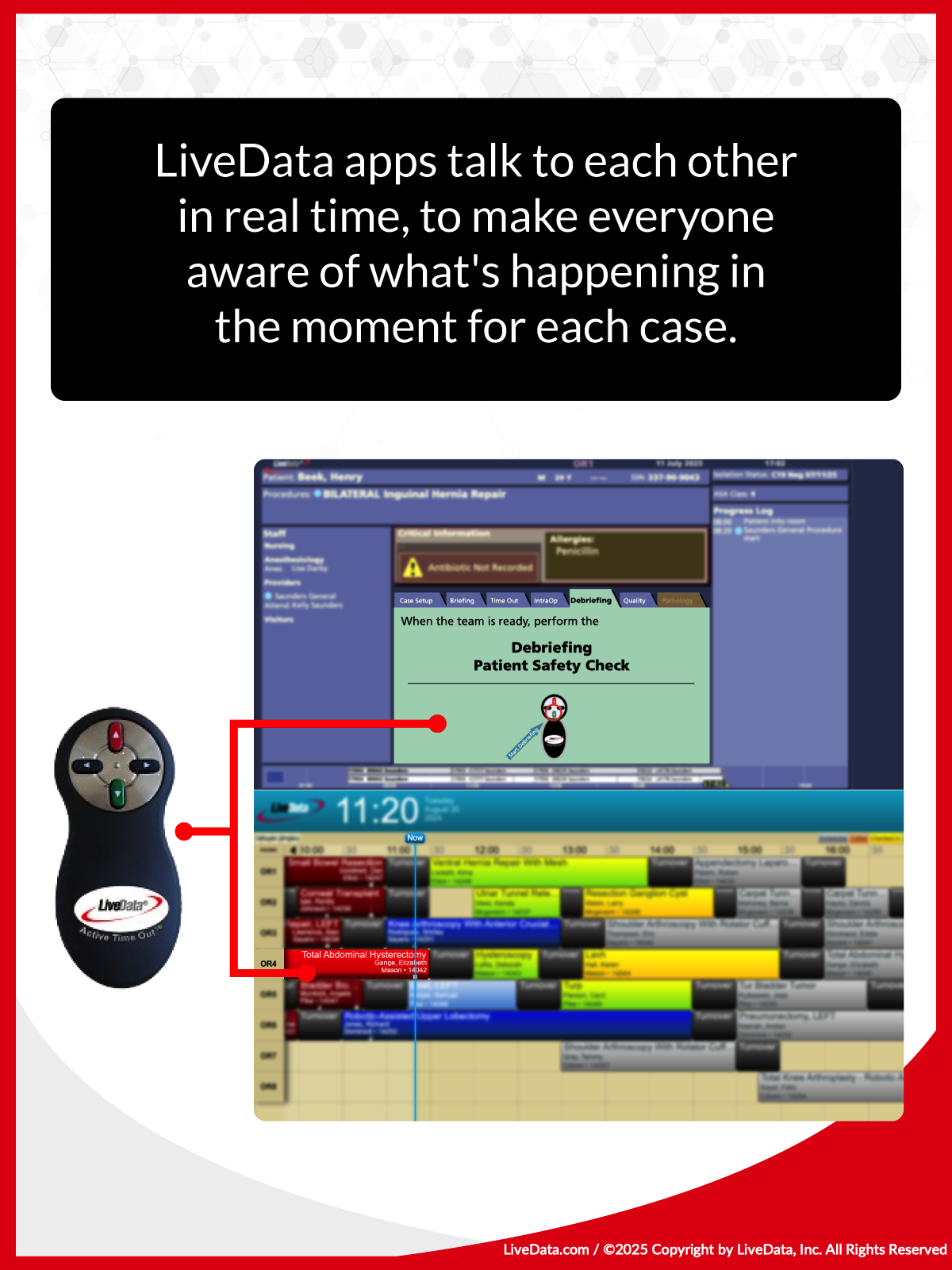
Another essential day-of-surgery display is the Family Waiting Board. This is placed in waiting rooms, cafeterias and other high traffic areas where caregivers gather. It provides digital updates complemented by mobile messaging to let family members know where their loved ones are in the process, such as when the procedure has begun or the patient has been moved to the recovery room.
For HIPAA compliance and complete patient privacy, anonymous IDs are assigned to each surgery patient and shared with approved family members. An added bonus is less disruption to workflows. Surgeries can be tracked while avoiding frequent check-ins at the nurses station. Families can even sign up for text messages, leave the facility, and still get updates.
PeriOp Manager Analytics
LiveData’s entire platform helps to drive smarter decision-making within the OR, and driving those data-driven decisions is the Analytics dashboard. Operational insights can be provided broadly by service line or specifically by room, surgeon, procedure type, nurse, etc. Updates happen every evening at midnight so staff can see everything that happened in the OR the day before.
Whereas nurses frequently have to dig through multiple screens in the EHR to compile info on their own, Analytics has been shown to cut a week’s worth of manual work to an hour or less by making it easy to collect and use recent data. It has strengths in shareability, making data easy to send over the web, email, or print. LiveData also plans to continually update its analytics platform to surface information in more areas and make the UI more beautiful in design.
LiveData’s ROI – More Bang for Your OR Buck
PeriOp Manager helps hospitals quickly attract new surgical cases and procedures, while reducing cancellations, driving positive ROI in 6 months or less. You can expect:
- Quick adoption – users typically see full usage less than 90 days after project launch
- Higher OR capacity/occupancy – more cases equals more revenue (each additional surgical case is roughly $5,000 net contribution margin) and fewer lost cases to competitors
- More for your EHR investment – integrating LiveData solutions into your EHR brings world-class tools and consumer-grade scheduling functionality to perioperative suites and procedure rooms, the revenue drivers for hospitals
- Robust analytics – data and insights that help you continuously improve surgery scheduling and capacity management
- More positive perceptions of care from patients and their caregivers – plus less staff and surgeon burnout and more satisfaction
- Insight into future caseloads – makes for more informed budgeting and easier prediction of volumes (e.g., surgeons might take vacations on “lighter weeks” or get better prepared for high volume weeks)
- Intel on throughput inefficiencies – insights and a positive impact on the entirety of the surgical journey, from scheduling to day-of awareness
- Improvement of on-time starts – particularly crucial for first case of the day to avoid costly tardiness (one US health system lost nearly $390,000 annually due to late starts for the first case of the day) and the snowball effects such as overtime charges and patient and staff dissatisfaction; users have reported up to 2X improvements in their first case on-time starts and near total compliance with their previously overlooked safety checklists
This tactical solution not only solves nuanced OR throughput and scheduling coordination problems, but has been proven to fill operating rooms by reducing cancellations and attracting new cases. PeriOp Manager has been shown to increase block utilization by an average of 34 percent, decrease cancellations by an average of 54 percent, and increase case volume by an average of 5 percent.
What’s the Scale of the LiveData Platform Today, and Who Is LiveData Right For?
LiveData is used in 700+ surgical suites over 85+ hospitals across 43 US states. They’re looking to partner with hospitals and health systems that have a site with at least 3 operating rooms (more rooms are even better) and use MEDITECH, Cerner or smaller EHRs.
Frequently, their customers are in rural or competitive markets which can make it difficult to attract attention and cases, or compete with systems that are doing a better job of scheduling.
Potential customers may be struggling with disparate systems or clunky analytics that take a while to use, drive communication challenges, and obscure visibility into daily operations. Or they may be looking to get a better handle on surgical operations over time, drive more revenue through their perioperative suite, or improve patient safety. Or they may need better management of their existing volume.
For hospitals and ASCs navigating short-term fiscal turbulence, LiveData offers a fast path to better financial footing.
For hospitals planning long-term transformation, PeriOp Manager lays a durable foundation for a modern, high-performing surgical department. It enables hospitals to:
- Measurably improve a wide range of KPIs and service lines
- Preserve and grow their share of the regional market
- Establish flexible, digital-first workflows
- Enhance patient experience and satisfaction
- Support diversification of their payor mix
- Capture rich operational data to enable future AI capabilities
The Outlook for LiveData: More Features, Better Analytics, Efficient ORs
LiveData, which was recently rated the #1 Inpatient Surgical and Perioperative Solution in the most recent Black Book Research Survey of 14,000+ hospital leaders, has a proven history of building upon its success.
As LiveData continues to expand its smart OR platform, they’ve accelerated developer investment into making the platform better for its partners. There’s an existing product roadmap underway for enhanced predictive capabilities, seamless staff scheduling, even more robust analytics, and additional AI notifications throughout all workflows.
If you could stand to improve your perioperative or procedure service line operations, schedule a demo with LiveData’s team here to discuss your workflows – before, during, and after surgery.
Join my Hospitalogy Membership! If you’re a VP or Director working in strategy or corporate development at a hospital, health system or provider organization, you will get a lot of value out of my community as I purpose-build the content, fireside chats, and conversations for this group. Apply Here.


